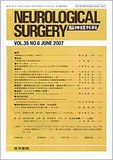Japanese
English
- 有料閲覧
- Abstract 文献概要
- 1ページ目 Look Inside
- 参考文献 Reference
Ⅰ.はじめに
前下小脳動脈瘤(以下AICA動脈瘤)は,稀な動脈瘤であり,特にAICA末梢動脈瘤は,本邦のSuzukiら21)のシリーズ全動脈瘤,3,899個中4例0.1%であり極めて稀である.そして血管内塞栓術が進歩した近年では,いっそう外科的直達手術を経験することは少なくなった.われわれは,1996年1月~2006年8月の間に1,035個の嚢状および解離性動脈瘤に対して984件のクリッピング(トラッピングを含む)および51件の血管内塞栓術を施行したうち,末梢部を含むAICA動脈瘤3例(0.29%)を経験し,また1995年以前に筆者らが経験した既報の1例3)を加えた計4例のAICA 動脈瘤に対して外側後頭下開頭(lateral suboccipital retrosigmoid approach,以下LSRA)による直達手術を施行した.4例の内訳は,AICA anterior pontine segmentの破裂解離性動脈瘤で血行再建術を行い解離部のトラッピングを施行した1例,破裂Acom動脈瘤に合併した未破裂BA-AICA動脈瘤の1例,AVMに合併したmeatal loop の破裂動脈瘤の1例と既報の破裂BA-AICAの1例の計4例である.4例のLSRAの検討と血管内塞栓術につき若干の文献考察を加え,またAICA末梢動脈瘤を,発生部位により親血管閉塞が生命的予後に関与するか否かで2グループに分けた,簡便で臨床上有用な分類法を提案した.
Anterior inferior cerebellar artery (AICA) aneurysms are very rare. We carried out four direct operations for AICA aneurysms including two distal AICA aneurysms using lateral suboccipital retrosigmoid approaches (LSRA). We successfully performed the clipping by LSRA, but hearing loss occurred except in one of our cases which involved a chronic term operation in our cases. In a 72 years old female with a ruptured dissecting aneurysm of the AICA anterior pontine segment, we performed the OA-PICA anastomosis first because of its being an AICA-PICA type, and then we continued to carry out the trapping operation of dissecting artery on day 0. She left our hospital cheerfully but hearing loss persisted on the operated side. Four examples of the dissecting aneurysm of AICA anterior pontine segment have been reported, but only our case involved the trapping with revascularization in acute stage.
At the moment, there is no clinical or useful classification for distal AICA aneurysm because it is extremely rare. We will now propose a new classification. This classification is divided into two groups, (1) P (pons) -group and (2) C (cerebellum) -group. The P-group consists of pA (AICA anterior pontine segment), pL (lateral branch on the pons to the meatal loop) and pM (medial branch on the pons). C-group consists of m-loop (meatal loop), cL (lateral branch post meatal loop) and cM (medial branch on the cerebellum). From results of case reports (75 distal AICA aneurysms), we found that pA: 5 (6.7%), pL: 2 (2.8%), pM: 0, m-loop: 54 (72%), cL: 8 (11%), cM: 6 (8.3%). The followings factors were also found. (1) Occlusion of the parent artery of P- group without revascularization of peripheral circulation may entail the risk of death. (2) On the other hand, as for the C-group, the parent artery was able to be occluded without severe consequences, but hearing loss and/or cerebellar infarction occurred. We believe that this classification is simple and very useful for therapeutic strategies in both direct surgery and intravascular treatments for distal AICA aneurysms.

Copyright © 2007, Igaku-Shoin Ltd. All rights reserved.


